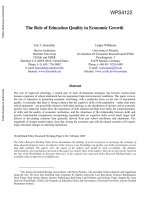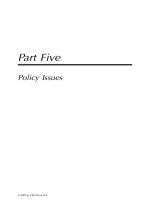Poor training quality in vietinbank – x branch’s enterprise customer department
Bạn đang xem bản rút gọn của tài liệu. Xem và tải ngay bản đầy đủ của tài liệu tại đây (2.62 MB, 93 trang )
UNIVERSITY OF ECONOMICS HO CHI MINH CITY
International School of Business
------------------------------
VƯƠNG THỊ HƯỜNG
POOR TRAINING QUALITY IN
VIETINBANK – X BRANCH’S
ENTERPRISE CUSTOMER
DEPARTMENT
MASTER OF BUSINESS ADMINISTRATION
Ho Chi Minh City – Year 2019
UNIVERSITY OF ECONOMICS HO CHI MINH CITY
International School of Business
------------------------------
VƯƠNG THỊ HƯỜNG
POOR TRAINING QUALITY IN
VIETINBANK – X BRANCH’S
ENTERPRISE CUSTOMER
DEPARTMENT
MASTER OF BUSINESS ADMINISTRATION
SUPERVISOR: ĐOÀN ANH TUẤN
Ho Chi Minh City – Year 2019
Table of Contents
Executive summary ......................................................................................................... 7
CHAPTER 1: COMPANY INTRODUCTION ................................................................ 8
1.1. General information about Vietinbank – X branch ................................................ 8
1.2. Enterprise customer department ............................................................................ 9
CHAPTER 2: SYMPTOMS ............................................................................................ 11
2.1. High turnover rate .................................................................................................11
2.2. Low sale ............................................................................................................... 12
2.2.1. Deposit mobilizing activity ................................................................................ 12
2.2.2. Credit activity .................................................................................................... 14
2.3. High non-performing loans ratio ........................................................................... 16
2.4. High provisioning expense .................................................................................... 19
2.5. Low profit ............................................................................................................. 23
CHAPTER 3: PROBLEM IDENTIFICATION ............................................................... 27
3.1. Potential problems ................................................................................................ 27
3.1.1. High workload ................................................................................................... 27
3.1.2. Incompatible compensation policy ..................................................................... 30
3.1.3. Poor training courses ......................................................................................... 32
3.2. Validating problems:............................................................................................. 35
3.2.1. Managers’ perspectives ..................................................................................... 35
3.2.2. Employees’ perspectives.................................................................................... 37
3.3. The importance of main problem .......................................................................... 37
CHAPTER 4: CAUSE VALIDATION ............................................................................ 39
4.1. Potential causes.....................................................................................................39
1
4.1.1. Unclear Training objectives ............................................................................... 41
4.1.2. Unprofessional trainers ...................................................................................... 41
4.1.3. Poor methods ..................................................................................................... 42
4.1.4. Unpractical training contents ............................................................................. 43
4.1.5. Inefficient training time management ................................................................ 44
4.1.6. Inappropriate frequency of training.................................................................... 44
4.1.7. Insufficient training amenities ........................................................................... 44
4.1.8. Lack of training evaluation ................................................................................ 45
4.2. Validating causes.................................................................................................. 45
4.2.1. Unclear Training objectives ............................................................................... 45
4.2.2. Unprofessional trainers ...................................................................................... 46
4.2.3. Lack of training evaluation ................................................................................ 46
CHAPTER 5: ALTERNATIVE SOLUTION ..................................................................48
5.1. Solutions for setting clear training objectives ........................................................ 50
5.2. Solutions for developing professional trainers ....................................................... 55
5.3. Solutions for improving the quality of training evaluation.....................................59
CHAPTER 6: ACTION PLAN ........................................................................................ 64
Conclusion ...................................................................................................................... 69
Supporting Information ...................................................................................................70
References ....................................................................................................................... 82
Appendix 1 ...................................................................................................................... 86
Appendix 2 ...................................................................................................................... 88
Appendix 3 ...................................................................................................................... 90
2
List of Abbreviations
Vietinbank
Vietnam Joint Stock Commercial Bank for Industry and Trade
NPL
Non - Performance Loan
ECD
Enterprise Customer Department
HRD
Human Resource Department
DOB
Director of Board
3
List of Tables
Table 1: Concepts about Kinds of Credit Group .............................................................. 18
Table 2: Non – Performing Loans of X Branch and Enterprise Customer Department
in 2018 ............................................................................................................................ 18
Table 3: Ratio of Specific Provision ............................................................................... 20
Table 4: The Profit of X Branch’s Enterprise Customer Department, X Branch and
HCM Region’s Enterprise Customer Department ............................................................ 24
Table 5: A Summary of Some Researchers' Comments on the Role of Key Factors in
a Training Course ............................................................................................................ 49
Table 6: Estimated Costs for Solutions to Improve the Quality of Trainers ..................... 59
Table 7: Estimated Costs for Solutions to Improving the Quality of Training
Evaluation ....................................................................................................................... 61
Table 8: Estimated Costs of Kaufman's Training Evaluation Method .............................. 62
Table 8: Action Plan ....................................................................................................... 68
4
List of Figures
Figure 1: Human Resource Structure According to Work Experience of Enterprise
Customer Department in 2018 ......................................................................................... 11
Figure 2: Turnover Rate from 2016-2018 in X Branch’s Enterprise Department ............. 12
Figure 3: Total Deposits of X Branch and Enterprise Customer Department in 2018 ...... 13
Figure 4: The Rate of Implementing Deposit Mobilization Plan in 2018 of X Branch
and Enterprise Customer Department .............................................................................. 14
Figure 5: The Average Productivity of Deposit Mobilizing Implementation of the
Enterprise Customer department in X Branch and HCM City Region .............................. 15
Figure 6: Credit Balance of the Enterprise Customer Department in 2018 ...................... 15
Figure 7: Productivity of Credit Activity in 2018 ............................................................ 16
Figure 8: The NPL ratio of X Branch’s Enterprise Customer Department, X Branch
and HCM Region’s Enterprise Customer Department ...................................................... 19
Figure 9: Loan Debt Ratio without Collateral of X Branch, the Enterprise Customer
Department and HCM Region ......................................................................................... 21
Figure 10: Provision Expense of X Branch in 2018 ........................................................ 22
Figure 11: Proportion of Provision Expense of X Branch and HCM Region in 2018 ...... 22
Figure 12: Total Profit after Deducting Provisions of X Branch and HCMC Region in
2018 ................................................................................................................................ 23
Figure 13: The Rate of Implementing Profit Plan in 2018 ............................................... 25
Figure 14: ROA of X Branch and HCM Region in 2018................................................. 26
Figure 15: The Average Income of Some Commercial Banks in 2018 ............................ 31
5
List of Diagrams
Diagram 1: Organization of Operation of X Branch ....................................................... 9
Diagram 2: A Model of Job Stress .................................................................................. 29
Diagram 3: The Initial Cause – Effect Map ..................................................................... 35
Diagram 4: Updated Cause – Effect map of Enterprise Customer Department................. 41
Diagram 5: Final Cause – Effect Map of the customer Department ................................. 47
Diagram 6: The Analysis Process of Employees’ Performance ........................................ 52
6
Executive Summary
Under strong competitive pressure among commercial banks today, the
working environment at banks has become more stressful than ever and more than all
other industries. Banks are constantly modernizing by applying many modern
technologies to the development of new products, increasing utility for consumers.
However, the quality of the workforce remains a key to the success of commercial
banks. They are the bridge connecting banks and customers. With that great role, the
workforce in Vietinbank – X branch’s enterprise customer department has constantly
made efforts to improve the professional level to meet the highest requirements for
work. That the volume of daily processing work is higher, the pressure of work is
higher, but the proportion of inadequate income makes the rate of quitting work at this
department increasing. The new employees are lack of real experiences, skills and not
met the work requirements. The above factors have partly caused negative impacts on
the current business results of X branch.
Realistically, the biggest problem of Vietinbank - X branch is facing is the poor
quality of training. This makes the new workforce in the enterprise customer
department fail to meet the work requirements promptly. The quality of customer
appraisal in this department decreases and makes bad debt increase (1). In addition,
the lack of skills in sales has also resulted in a significant reduction in credit and
capital sales. Poor working capacity has partly increased the work pressure for
employees in this department, increasing turnover rate at the branch.
With certain limitations, this study desires to offer effective solutions to
promote the quality of training at X branch in particular and at Vietinbank system in
general. From there, X branch’s business activity will become more and more
developed. Its business cost will decrease and its profit will increase. The welfare
policies for its employees will also be improved.
7
CHAPTER 1: COMPANY INTRODUCTION
1.1. General information about Vietinbank – X branch
Vietnam Joint Stock Commercial Bank for Industry and Trade (Vietinbank) - X
branch was established in the early days of Vietinbank in operation (26th March,
1988). The head office of the branch is located at district 8, Ho Chi Minh City and has
transaction offices scattered in districts 8,10,11. The total number of current
employees of the branch consists of 116 employees and has 15 departments.
Moreover, the branch provides all the products that Vietinbank has with the
diversity and outstanding competitiveness compared to other banks in the same area:
Savings deposits, deposits flexible accumulation, lending to large enterprises, small
and medium enterprises, small households, super-large enterprises, card products, etc.
The branch does not contribute greatly to the development of Vietinbank, but also
help to building a local economy to develop and actively support individuals and
organizations in the area with conditions to build families and develop business
activities.
Since its establishment, the branch always strives to complete all tasks assigned
by Vietinbank excellently. Particularly in 2018, due to the increase in bad debt,
business efficiency brought quite limited and only completed the tasks.
Over 30 years of operation, the total deposits at the end of the period at 31st
December, 2018 is VND 5,907 billion, accounting for 2% of the total deposit in the
Ho Chi Minh city area and the total outstanding loans are VND 3,598 billion,
accounting for 1% of the region's total outstanding loans with the total profit achieved
after setting up the risk provision to the end of February, 2019 is VND 16,839 million.
8
Director
Vice
presidents
Enterprise
customer
department
Retail
customer
department
Accounting
department
Transaction
offices
Monetary
treasury
departme
nt
Transaction office
-Binh Dien
Transaction
office - Hung
Phu
Transaction office
-Pham Hung
Transaction office
- Xom Cui
Transaction office
-Lakai
Transaction office
-Rach Ong
Transaction office
-Minh Phung
Synthetic and
marketing
department
Transaction office
-Binh Dang
Diagram 1: Organization of Operation of X branch.
1.2. Enterprise Customer Department
The enterprise customer department is one of the key departments of X branch
in generating revenue and profit. The department currently has 17 employees
including 2 management leaders, 13 officers in charge of small and medium
enterprises, 1 officer in charge of large enterprises and 1 trade finance officer. The
9
main activity of the department is lending and raising deposit from corporate
customers, cross-selling other products. Total outstanding loans of this department at
31st December, 2018 were VND 2,509 billion and the total deposit was VND 1,059
billion.
10
CHAPTER 2: SYMPTOMS
2.1. High turnover rate
Based on the working time to classify, the workforce in the department is
divided into 3 different types. Firstly, people with working experience from 3
years or more, including 6 people, accounting for 35.3% of the total number of
employees in this department. Secondly, people with experience from 1 to 3 years,
including 4 people, accounting for 23.5% of the total workforce. The rest are
employees with less than one - year experience. This is the segment that accounts
for the highest proportion of this department with 7 people, accounting for 41.2%
of the employees in this department.
Figure 1: Human Resource Structure According to Work Experience of Enterprise
Customer Department in 2018
The chart is below the description of the quitting work rate in the corporate
customer department from year 2016 to 2018. Accordingly, it shows that the rate
of this department was increasing: it was 16,7% in year 2016, year 2017 was
21.4%. And in 2018, the ratio of this department (35,3%) was higher than other
departments in X branch.
11
Figure 2: Turnover Rate from 2016-2018 in X Branch’s Enterprise Department
2.2. Low sale
Sales of loans and deposits are the two main criteria that the enterprise
customer department need to implement. However, the performance in 2018 of
this department is quite low compared to the yearly plan and Ho Chi Minh City
area.
2.2.1. Deposit mobilization activity
Total depositsof the enterprise customer department at 31/21/2018 was VND
1,059 billion, accounting for 17% of X branch’s total deposits and only reached
56.1% of year 2018’s plan. The implementation ratio was quite low compared to
the implementation rate of the retail department (VND 4,204 billion, reaching 97%
of year plan) and X branch's implementation rate (88.7%).
12
Unit: VND billion.
Figure 3: Total Deposits of X Branch and
Enterprise Customer Department in 2018
13
Figure 4: The Rate of Implementing Deposit Mobilization Plan in 2018 of X Branch
and Enterprise Customer Department
Compared to the average productivity of deposit implementation, the enterprise
customer department at X branch only reached VND 61 billion/employee. Meanwhile,
this index of the corporate customer department at HCM region was 149 billion
VND/employee.
Unit: VND billion/employee.
Figure 5: The Average Productivity of Deposit Mobilizing Implementation
of The Enterprise Customer department in X Branch and HCM City Region
2.2.2. Credit activity
At the end of 2018, the department achieved VND 2.509 billion, accounting for
64.7% of the outstanding loan of X branch and achieving 98.8% of business plan.
Compared to the retail department (104.5%) and X branches (100.8%), the rate of
enterprise customer department was still lower. In addition, the implementation of
the credit balance of this department had also tended to decrease: VND 2,586
billion in March, 2018 and VND 2,509 billion in December, 2018.
14
Figure 6: Credit Balance of the Enterprise Customer Department in 2018
Compared to the performance of the average credit balance, the enterprise
customer department only reached 140 billion VND/person, quite low compared to
the average performance of the business customers in Ho Chi Minh region (287
billion VND/person).
15
Figure 7: Productivity of Credit Activity in 2018
2.3. High non-performing loans ratio.
As Ali (2) said, credit risk is the most basic and important risk which banks
must be faced, because income from credit activities is one of the main sources of
commercial banks. In order to assess and analyze the quality of loans, the state
bank issued circular No. 02/2013/TT-NHNN on 21st February, 2013 with
accompanying amendments. On the basis of the circulars issued by the state bank,
Vietinbank has classified debts according to the following groups.
Ord.
Debts
Group 1 Standard
Debts
1
Current debts and are assessed
as fully recoverable both
principal and interest on time.
X
X
b
Overdue debts
Under 10 days and assessed
as being able to fully recover
overdue principal and interest
and
fully
recover
the
remaining
principal
and
interest on time.
From 10 days to 90 days
c
From 91 days to 180 days
d
From 181 days to 360 days
e
Over 360 days
Debts restructured repayment
term
Adjust the repayment term for
the first time
Debt extension for the first
time
Debts which are restructured
repayment term for the first
time but still overdue for less
than 90 days according to the
first restructured repayment
term
Debts
restructured
the
repayment term for the second
time
2
a
3
a
b
c
d
Group 2 Special
Mention
Debts
Group 3 Sub Standard
Debts
Group 4 Doubtful
Debts
Group 5 Potentially
Irrecoverable
Debts
X
X
X
X
X
X
X
X
16
e
g
h
4
5
a
b
c
6
a
b
c
7
a
b
Debts which are restructured
repayment term for the first
time but still overdue for a
period of 90 days or more
according
to
the
first
restructured repayment term
Debts which are restructured
repayment term for the second
time are overdue according to
the
second
restructured
repayment term
Debts
are
restructured
repayment term of three times
or more (even if they are not
overdue or overdue)
Debts are exempted or
reduced because customers
cannot afford to pay the full
interest according to credit
contracts
Debts in one of the following
cases have not been recovered
during the "Y" day from the
date of issuance of the
revocation decision:
Debts violated the provisions
of Clauses 1,3,4,5,6, Article
126 of the Law on Credit
Institutions in 2010
Debts violate provisions in
Clauses 1,2,3,4, Article 127 of
the Law on Credit Institutions
in 2010
Debts violated the provisions
of Clauses 1,2,5, Article 128
of the Law on Credit
Institutions in 2010
Debt at the request of the
State Bank (based on the
results
of
inspection,
supervision and related credit
information):
Debts must be classified into
group 3
Debts must be classified into
group 4
Debts must be classified into
group 5
Debts to be recovered
according
to
inspection
conclusions and:
During the recall period
Past the withdrawal time,
according
to
inspection
conclusions, 60 days have not
been recovered
X
X
X
X
Y<30
30 =
Y>60
X
X
X
X
X
X
X
X
X
X
X
X
X
X
17
c
8
Past the recovery time limit
according
to
inspection
conclusions over 60 days, it
has not been recovered yet
Debts of customers are credit
institutions announced by the
State Bank of Vietnam into
special control status, foreign
bank branches are blocked
with capital and assets.
X
X
Table 1: Concepts about Kinds of Credit Group
From January to June of 2018, X branch’s NPL ratio reached about 0.1% to
0.2%, that was much lower than the average ratio of Ho Chi Minh city region
(from 1.5 % - 1.7%). However, at the end of July, 2018, the NPL ratio of X branch
suddenly increased from 0.2% in June, 2018 to 4.4%, far exceeding the average
index of the region (1,7%). This ratio remained stable or only slightly changes
from 3.8% to 4.4% and is quite high compared to the general situation in the
region. The peak of the sudden increase in this index was December, 2018 with
11.9%, far exceeding the region's average NPL ratio (2.5%). At that time, the total
NPL of X branch was VND 429,003 million, an increase of VND 278,361 million
(an increase of 184.8%) compared to November, 2018. This makes the provision
expenses of X branch increase and reduce the year-end profit.
Unit: VND million.
Kind of Loan
Non-performing
Loans
Substandard
01
Loans
Jan
Feb
Mar
Apr
May
June
July
Aug
Sep
Oct
Nov
Dec
3.855
3.855
4.271
3.855
4.442
7.769
170.581
170.581
149.594
150.642
150.642
429.003
3.855
3.855
2.598
-
587
587
168.398
167.812
146.826
1.638
1.638
280.000
146.821
02
Doubtful
Loans
-
-
1.673
3.855
3.855
2.182
2.182
2.769
2.769
146.821
146.821
03
Loss Loans
-
-
-
-
-
5.000
-
-
-
2.182
2.182
Table 2: Non – Performing Loans of X Branch and Enterprise Customer
Department in 2018
18
2.182
All non – performing loans of X Branch are the enterprise customer
department’s loans. In January 2018, this ratio of the enterprise customer department
was 0.2% and remained slight fluctuations until June 2018. In July 2018, this index
increased suddenly to 6.9% and then fluctuated slightly until November 2018.
However, this ratio increased sharply to 18.1% at 31th December, 2018.
Figure 8: The NPL ratio of X Branch and HCM region’s Enterprise Customer
Department, X Branch’s and HCM Region’s Enterprise Customer Department
2.4. High provisioning expense
The specific provision amount for each customer is calculated according to the
following formula:
In which:
R: The total specific provision amount must be deducted from each customer.
: The total specific reserve amount of each customer from the 1st loan
to n.
19
: The specific provision amount to be deducted from each customer for the
principal balance of loan i. Ri is determined by the formula:
Ri = (Ai – Ci) x r
In which:
Ai: Balance of principal loan i.
Ci: Deductible value of security assets, financial leasing assets (hereinafter
referred to as security assets) of loan i.
r: Specific rate of provisioning.
The specific provision rate for each credit group is as follows:
Group
Group 1
Group 2
Group 3
Group 4
Group 5
Ratio of Specific
Provision
0%
5%
20%
50%
100%
Table 3: Ratio of Specific Provision
Although, the ratio of X branch’s non-secured loans decreased gradually
in the last months of the year, the cost of provisioning and provision
expenses/total debt ratio increased gradually for these months.
20
Figure 9: Loan Debt Ratio without Collateral of X Branch, the Enterprise
Customer Department and HCM Region
Specifically, the provision expense of X branch increased from January to
December with many sudden changes. At the end of January, 2018, the cost of
provisioning of the branch was VND 700 million (accounting for about 0.02% of
total outstanding loans). But in February, 2018, provision expenses increased to
VND 3,734 million compared to the end of January, up VND 3,034 million,
equivalent to 433.3%. In the Feb, March and April, the fluctuations are not
significant. In May, it increased sharply compared to April, reaching VND 7,375
million, up VND 2,800 million compared to April, corresponding to an increase of
61.2%. Cost of provisioning fluctuates slightly in June and July. Through
September, there was a big fluctuation when it reached VND 18,218 million. The
risk provisioning expense, increased VND 10,504 million compared to the
previous month, equivalent to an increase of 136.2%. In October, it increased by
34.4% compared to September. The cost of provision in November doubled this
cost in October, reaching VND 52,888 million. And at the end of December, this
cost increased by VND 20,897 compared to November and reached VND 73,785
million.
21
Figure 10: Provision Expense of X Branch in 2018
About the ratio of provision expenses of X branch to the total outstanding
loans, this ratio has increased over the months and by November and December, this
ratio was higher than that of HCMC region.
Figure 11: Proportion of Provision Expense of X Branch and HCM Region in
2018
22
2.5. Low profit
Unit: VND billion
Figure 12: Total Profit after Deducting Provisions of X Branch and HCMC Region in
2018
Post-provision profit of X branch in the last months of the year 2018 tended to
decrease and lower than the regional average. From January to October, the profits of
the branch increased. However, in November, the profit began to decrease with a
decrease of VND 16,859 million, corresponding to a decrease of 14.1% compared to
the end of October. In December, the profit continued to decrease by VND 13,633
million, equivalent to a decrease of 13, 3% compared to November and reached VND
89,075 million.
23









